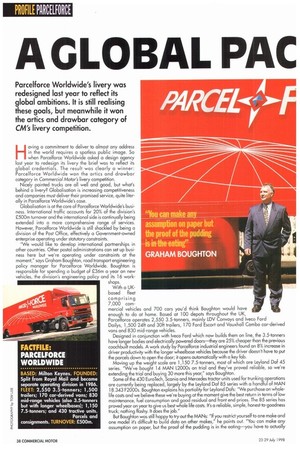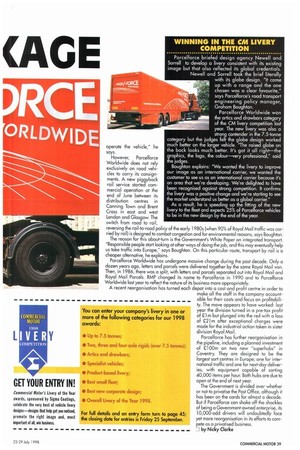AGLO
Page 40

Page 41

If you've noticed an error in this article please click here to report it so we can fix it.
I3AL PAC
(AG
Parcelforce Worldwide's livery was redesigned last year to reflect its global ambitions. It is still realising these goals, but meanwhile it won the oaks and drawbar category of CM'S livery competition.
Having a commitment to deliver to almost any address in the world requires a spotless public image. So when Parcelforce Worldwide askec a design agency last year to redesign its livery the brief was to reflect its global credentials. The result was clearly a winner: Parcelforce Worldwide won the artics and drawbar category in Commercial Motor's livery competition.
Nicely painted trucks are all well and good, but what's behind a livery? Globalisation is increasing competitiveness and companies must deliver their promised service, quite literally in Parcelforce Worldwide's case. Globalisation is at the core of Parcelforce Worldwide's business. International traffic accounts for 20% of the division's £500m turnover and the international side is continually being extended into a more comprehensive range of services. However, Parcelforce Worldwide is still shackled by being a division of the Post Office, effectively a Government-owned enterprise operating under statutory constraints. "We would like to develop international partnerships in other countries. Other postal administrations can set up business here but we're operating under constraints at the moment," says Graham Boughton, road trcsnsoart engineering policy manager for Parcelforce Worldwice. Boughton is responsible For spending a budget of £36m a year on new vehicles, the division's engineering policy and its 16 work shops.
With a UKbased fleet comprising 7,000 commercial vehicles and 700 cars you'd think Boughton would have enough to do at home. Based at 100 depots throughout the UK, Parcelforce operates 2,550 3.5-tonners, mainly LDV Convoys and lveco Ford Dailys, 1,500 24ft and 30ft trailers, 170 Ford Escort and Vauxhall Combo car-derived vans and 830 mid-range vehicles. Designed in conjunction with Iveco Ford which now builds them on line, the 3.5-tonners have longer bodies and electrically powered doors—they are 25% cheaper than the previous coachbuilt models. A work study by Parcelforce industrial engineers found an 8% increase in driver productivity with the longer wheelbase vehicles because the driver doesn't have to put the parcels down to open the door; it opens automatically with a key fob. Moving up the weight scale are 1,150 7.5-tanners, most of which are Leyland Daf 45 series. "We've bought 14 MAN L2000s on trial and they've proved reliable, so we're extending the trial and buying 30 more this year," says Boughton. Some of the 430 EuroTech, Scania and Mercedes tractor units used For trunking operations are currently being replaced, largely by the Leyland Daf 85 series with a handful of MAN 18.343 F2000s. Boughton explains his partiality for Leyland Dafs: "We purchase on wholelife costs and we believe these we're buying at the moment give the best return in terms of low maintenance, Fuel consumption and good residual and front end prices. The 85 series has proved year on year to give us best whole life costs. It's a reliable, simple, honest-to-goodness truck; nothing flashy. It does the job." But Boughton was still happy to try out the MANs: "If you restrict yourself to one make and one model it's difficult to build data on other makes,' he points out. "You can make any assumption on paper, but the proof of the pudding is in the eating—you have to actually operate the vehicle," he says.
However, Parcelforce Worldwide does not rely exclusively on road vehicles to carry its consignments. A new piggyback rail service started commercial operation at the end of June between its distribution centres in Canning Town and Brent Cross in east and west London and Glasgow. The switch from road to rail, reversing the rail-to-road policy of the early 1980s (when 90% of Royal Mail traffic was carried by rail) is designed to combat congestion and for environmental reasons, says Boughton. The reason for this about-turn is the Government's White Paper on integrated transport. "Responsible people start looking at other ways of doing the job, and this may eventually help us take traffic into Europe," says Boughton. On this particular route, transport by rail is a cheaper alternative, he explains. Parcelforce Worldwide has undergone massive change during the past decade. Only a dozen years ago, letters and [parcels were delivered together by the same Royal Mail van. Then, in 1986, there was a split, with letters and parcels separated out into Royal Mail and Royal Mail Parcels. RMP changed its name to Parcelforce in 1990 and to Parcelforce Worldwide last year to reflect the nature of its business more appropriately.
A recent reorganisation has turned each depot into a cost and profit centre in order to Boughton explains: "We wanted the livery to improve our image as an international carrier, we wanted the customer to see us as an international carrier because it's an area that we're developing. We're delighted to have been recognised against strong competition. It confirms the livery was a positive change and we're starting to see the market understand us better as a global carrier."
As a result, he is speeding up the fitting of the new livery to the fleet and expects 25% of Parcelforce vehicles to be in the new design by the end of the year.
make all the staff in the company account able for their costs and focus on profitability. The move appears to have worked: last year the division turned in a pre-tax profit of £1m but plunged into the red with a loss of £21m after exceptional charges were made for the industrial action taken in sister division Royal Mail.
Parcelforce has further reorganisation in the pipeline, including a planned investment of £100m on two new "superhubs" in Coventry. They are designed to be the largest sort centres in Europe; one for international traffic and one for next-day deliveries, with equipment capable of sorting 110,000 items per hour. Both hubs are due to open at the end of next year.
The Government is divided over whether or not to privatise the Post Office, although it has been on the cards for almost a decade. But if Parcelforce can shake off the shackles of being a Government-owned enterprise, its 10,000-odd drivers will undoubtedly face yet more reorganisation in its efforts to compete as a privatised business. 7 by Nicky Clarke
FACTFILE: PARCELFCIRCE WORLDWIDE
BASED: Milton Keynes. FOUNDED: Split from Royal Mail and became separate operating division in 1986. FLEET: 2,550 3.5-tonners; 1,500 trailers; 170 car-derived vans; 830 mid-range vehicles (also 3.5-tonners but with longer wheelbases); 1,150 7.5-tonners; and 430 tractive units.
Parcels and consignments. TURNOVER: £500m.
WINNING IN THE CM LIVERY COMPETITION
Parcelforce briefed design agency Newell and Sorrell to develop a livery consistent with its existing image but that also reflected its global credentials. Newell and Sorrell took the brief literally with its globe design. "It came up with a range and the one chosen was a clear favourite," says Parcelforce's road transport engineering policy manager, Graham Boughton. Parcelforce Worldwide won the artics and drawbars category of the CM livery competition last year. The new livery was also a strong contender in the 7.5-tonne category but the judges felt the globe design worked much better on the larger vehicle. "The raised globe on the back looks much better. It's got it all right—the graphics, the logo, the colour—very professional," said the judges.
Boughton explains: "We wanted the livery to improve our image as an international carrier, we wanted the customer to see us as an international carrier because it's an area that we're developing. We're delighted to have been recognised against strong competition. It confirms the livery was a positive change and we're starting to see the market understand us better as a global carrier."
As a result, he is speeding up the fitting of the new livery to the fleet and expects 25% of Parcelforce vehicles to be in the new design by the end of the year.




































































































